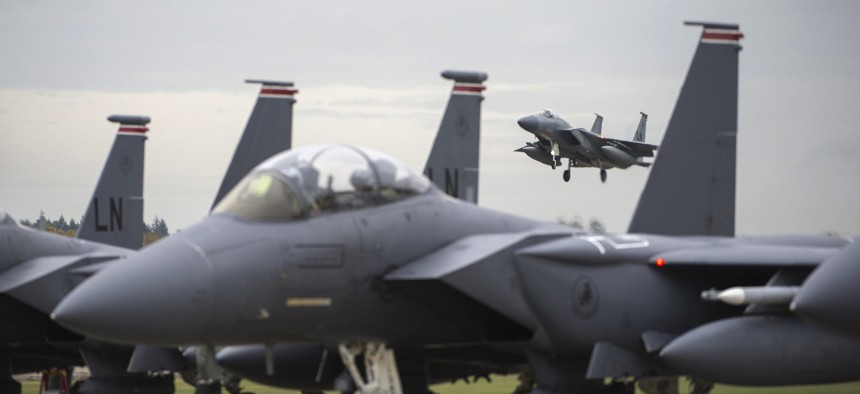
An F-15C Eagle from the 493rd Fighter Squadron, prepares to land on the flight line at Royal Air Force Lakenheath, England. U.S. Air Force / Staff Sgt. Emerson Nuñez
Airpower Gets a Big Boost in the Senate’s Authorization Bill
Air Force leaders won’t be entirely happy with it, but the country should be.
In a strong show of bipartisanship, the Senate Armed Services Committee last week approved its version of the National Defense Authorization Act with a 25-2 vote. While it must still earn full Senate approval and weather a House-Senate conference before it becomes law, this version of the NDAA has made four big moves that will improve Air Force capacity, capability, and posture for years to come.
More fifth-generation fighters. The Air Force budget has grown by more than 30 percent over the last four years. The lion’s share of that plus-up has gone toward developing future weapons and a digital communications infrastructure, all the while hoping that Congress would fund additional combat platforms for the service.
That strategy is paying off, at least in part, with the Senate bill. It authorizes the Air Force to procure 12 additional F-35As and to take possession of six more F-35As formerly bound for Turkey. When combined with the 48 fighters proposed in the president’s budget, the FY21 NDAA will add 65 sorely needed stealth fighters to the Air Force fleet.
386 operational squadrons is the new minimum. Two years ago, the Secretary of the Air Force and Air Force Chief of Staff unveiled “The Air Force We Need.” Based on thousands of wargame simulations, the study revealed that the service needed to grow from 312 to 386 operational squadrons to meet the demands of the 2018 National Defense Strategy. Among the “missing” squadrons were seven additional fighter squadrons, five additional bomber squadrons, and 14 additional tanker squadrons needed just to handle a peer-level fight with China or Russia.
Despite of that study, the Air Force kept its procurement budget flat, even as it proposed retiring the A-10, B-1, KC-10 and KC-135 aircraft—all but offsetting the capacity gains made by acquiring new weapons systems. The Senate committee bill rightly shifts “The Air Force We Need” from a “wish list” to a mandate—one that requires the service to build to the 386 operational squadron threshold.
No more aircraft retirements. Reinforcing the underlying premise behind a 386-squadron requirement, the NDAA establishes a minimum number of aircraft for each major mission area and prohibits the retirement of older aircraft until those minimums are achieved. This ensures the service moves more rapidly to meet its own stated requirements. It also effectively thwarts the service’s stated intent to retire 17 B-1 bombers, 44 A-10 fighters, 16 KC-10 and 13 KC-135 tankers in fiscal 2021. If the Air Force is unable to save money by divesting those platforms and receives no additional funding to sustain them, it will have to reallocate funds from other areas like Research, Development, Test, & Evaluation to make its budget work.
Preparing for a peer-level fight. At the height of the Cold War with the Soviet Union, the Air Force had more than 100 fighter squadrons ready to repel a Soviet attack, 29 of them based in Europe alone. It was a deterrent that worked.
Today, the active duty Air Force has 32 fighter squadrons. Ten are based in the Pacific; six are in Europe, and there is not a single fifth-generation F-35A squadron among them.
Related: What’s Wrong With the Air Force’s ‘Connect Everything’ Project
Related: How COVID-19 Kicked a USAF Software Team Into High Gear
The Senate committee bill forbids the Air Force to remove F-15C air superiority fighters currently based in Europe, and encourages the Air Force to base F-35As in the Indo-Pacific region to deter, or immediately respond, to a hostile move in the region.
To emphasize the need to prepare for a war with a peer competitor, the NDAA requires the Defense Secretary to recommend a minimum number of bombers that would give the Air Force the long-range, penetrating strike force it would need to hold the heartland of a peer adversary like China at risk.
Several of the directives within the Senate Armed Services Committee version of the NDAA will be tough pills for the Air Force to swallow, but the overall impact will benefit the service and our nation in a very positive way. The committee has done an excellent job for strengthening U.S. airpower.